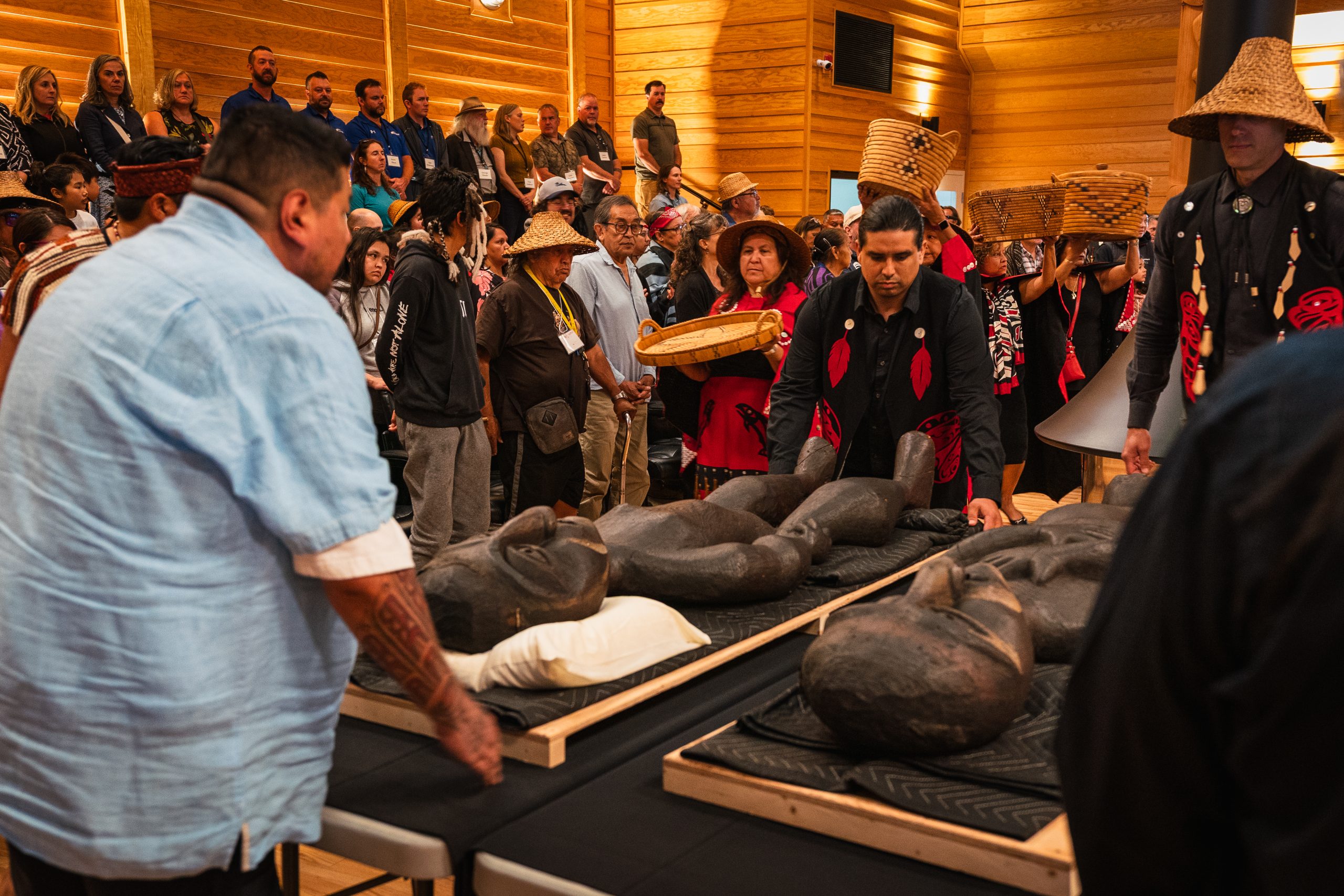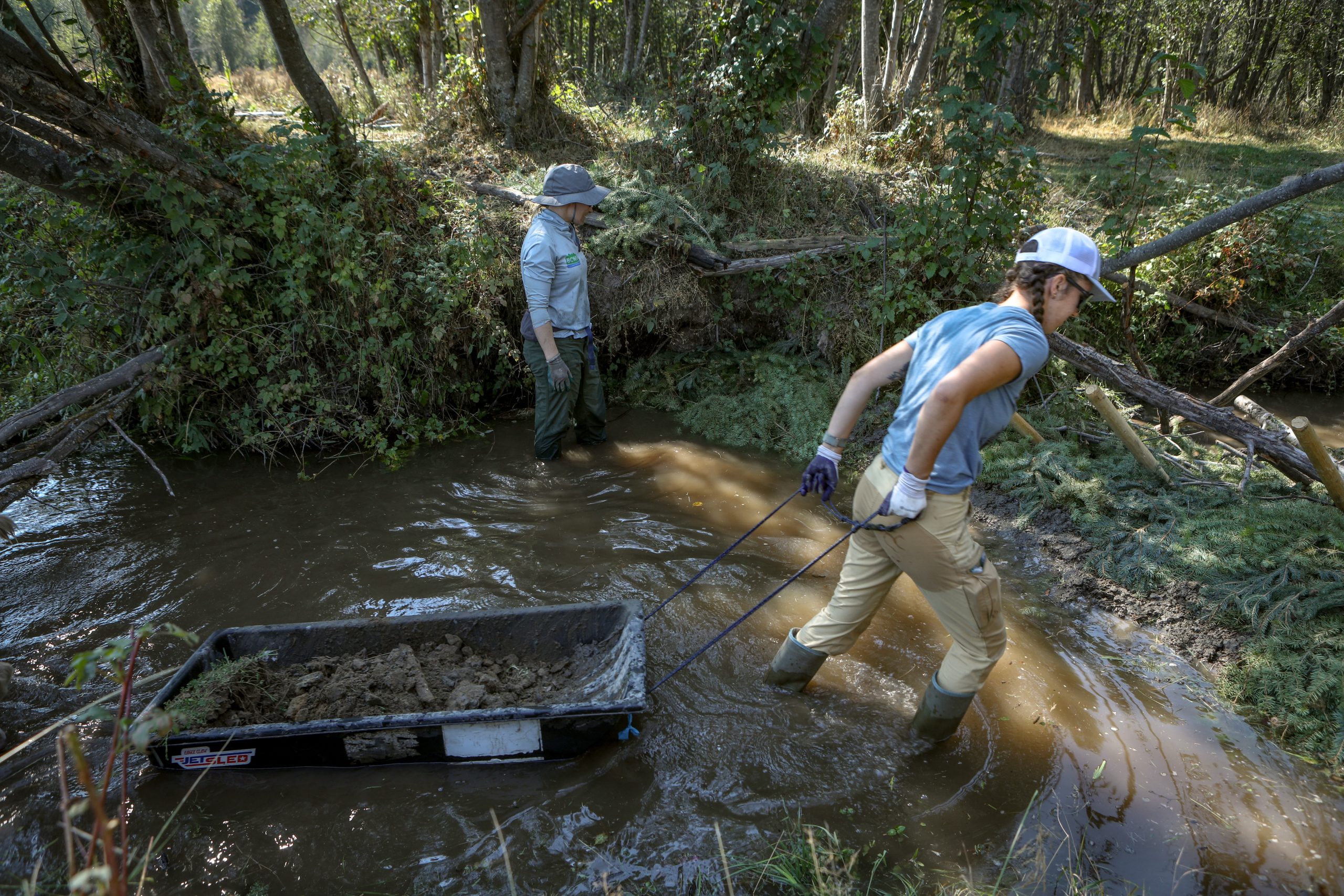‘Truly amazing and really emotional’: Historic mortuary poles returned to Tla’amin Nation after decades-long search
The nation celebrated the repatriation during the opening of a new cultural centre, part of a wider reclamation for the community


In late 2022, Drew Blaney was at the Museum of Anthropology (MOA) viewing some paddles and masks from his nation that were being held in the institution’s basement.
While he was walking around, the culture and heritage manager for Tla’amin Nation stumbled across two striking carved wooden figures — one depicting a man and the other depicting a woman holding her arms out, as if she was carrying a child.
They looked familiar, so he immediately sent a text to his brother, Tiy’ap thote (Erik Blaney), who had been searching for two mortuary poles belonging to their community for nearly three decades.
Blaney asked Tiy’ap thote — who was at a hockey game at the time — if he could send photos of the historic mortuary poles.
After a few minutes of trying to find service, “‘ding, ding, ding’ all these photos started popping up on my phone,” Blaney said.
“I’m standing there looking at the photos of the poles on my phone and sure enough it’s the same two mortuary poles that are standing there in the Museum of Anthropology.”

In return, Blaney sent his brother a photo of the poles in front of him. Tiy’ap thote said when he saw a photo of the mortuary poles he had been searching for pop up on his phone “I almost fell out of my seat.”
The two mortuary poles — along with paddles, masks, and baskets — have now been returned to Tla’amin as part of a repatriation from MOA and the Museum of Vancouver.
On June 21, National Indigenous Peoples Day, a ceremony was held in the nation to celebrate the return of the objects. Tla’amin is a self-governing nation located just north of “Powell River” on the upper Sunshine Coast.
The ceremony took place as part of a larger celebration for the opening of Ɂəms ʔayɛ (Our House), Tla’amin Nation’s brand new cultural centre, located in the village of Tł’ihšosum.
Ɂəms ʔayɛ is the first big house to be located in the Tla’amin’s territory in over 107 years, since the previous big house was destroyed by a fire in 1918.

More than 400 people, many wearing traditional regalia, came together from Tla’amin, Homalco, Klahoose, and K’ómoks — known as the four sister nations — to mark the occasion through songs, dancing, drumming, the repatriation ceremony, and a cedar braid cutting unveiling Ɂəms ʔayɛ.
Ɂəms ʔayɛ will serve as the community’s cultural space, spanning more than 1,390 square metres (15,000 square feet). The facility includes a feast hall, traditional foods facility, language lab, medicinal gardens, communal smokehouse, and museum to safekeep Tla’amins cultural belongings including the mortuary poles.
Reclaiming the mortuary poles
Mortuary poles are made to mark the gravesite of someone who has passed. Tla’amin Nation believes that these particular poles were marking the grave of a family who passed away together.
Before now, the only knowledge of the poles was through a photo taken on their original village site, tiskʷat, in the late 1800s. Tla’amin had been removed from the site, which became the “Powell River” “paper and pulp mill and later, Catalyst Paper Excellence.
A large part of the physical search and research for these poles was done by Tiy’ap thote, who is a legislator for Tla’amin.
He began looking for the two mortuary poles when he was 16 years old, after the late Elder Henry Bob told him a story about tiskʷat and the two poles. Tiy’ap thote said that Bob requested that he try to find the poles, and ever since he had been searching for them by researching the nation’s archives and hiking through Tla’amin lands.

His brother Blaney explained that over the years, Tla’amin had visited MOA many times, but never came to the realization that the poles were there until that visit in 2022.
He believes that part of the reasoning is due to the poles being previously mislabeled as Stó:lō Nation poles.
MOA’s director and curator Susan Rowley explained the origins of the poles had “always been a question,” because they were brought in as part of the Reverend George H. Raley collection after he passed away, and much of the documentation was lost. Raley was a former residential “school” principal of the Coqualeetza Industrial School in “Chilliwack,” according to the British Columbia Archival Information Network.
After confirming the poles belonged to Tla’amin, the nation and MOA began the process of repatriation and bringing the poles, masks and paddles back home last spring. Tla’amin’s plan was to house the poles and other items in Ɂəms ʔayɛ’s museum space once complete.
Rowley explained that because MOA is a part of University of British Columbia, this process is done in alignment with the university’s guidelines and policies around repatriation to work with communities.
‘A safe journey home’
Blaney said this year, on June 4 and 5, he along with some members of the nation — including council members and the hegus (chief) — had two small ceremonies at both MOA and MOV. They were joined by museum staff and a delegation from xʷməθkʷəy̓əm (Musqueam) Indian Band.

“We thought that was really important for us, because the poles have been standing in Musqueam territory for over 50 years,” said Blaney.
“Musqueam ancestors have been there, they’ve touched these poles … They shared their paddle song with us for a safe journey home for the mortuary poles.”
In the end, the poles traveled home in a U-Haul. Blaney said they were strapped down to a wooden platform inside the vehicle to keep them safe.
He took his brother Tiy’ap thote to see the poles first thing in the morning when they arrived home, which he described as an emotional moment. He said “every step of this journey has been truly amazing.”
“You know, from seeing the photos as a young person, working for the treaty department in my teen years, doing the research on that. Then all the tiskʷat questions, seeing that photo come up many times,” Blaney said.
“And then fast forward to now, going to the museum, finding them, having them come home like every step of it has been truly amazing and really emotional.”

Tiy’ap thote shared that bringing the poles back has been a significant time for the whole community. Last year, Tla’amin submitted a specific claim to the federal government for tiskʷat, at the same time they were in communications with Domtar (formerly, Catalyst Paper Excellence) to purchase back their original village and mill site.
As of March 17, 2025, the parties reached an agreement, and Tla’amin now owns most of tiskʷat.
“The journey home is obviously something that brings up a lot of emotion, since we’re heavily involved in, you know, the land back portion of getting tiskʷat back,” he said.
“So the significance is huge in that everything seems to be coming back that we lost, and opportunities are now here. I mean, the timing is just unbelievable, really, to think that, you know, we lost these 130-140 years ago, and they’re [tiskʷat and the mortuary poles] coming back just in the same year … It just feels like it’s now full circle.”
‘It’s our home’
Now, as the nation celebrates Ɂəms ʔayɛ, tiskʷat, and the poles, Tiy’ap thote said the next big project he’d like to do is creating a 3D map of tiskʷat’s village.
“I want to have a visual of what it would have looked like pre contact, and obviously taking pieces of our history, archives, records, and photos. I think this is the next step, or the next phase of that sort of project is; ‘fan out. Let’s get some summer students out into the museums and find more artifacts and build more of the story,’” said Tiy’ap thote.
“But let’s also get in our people’s mind what the village would have looked like back in the day, and start thinking about what life would have been like 1,000 years ago at tiskʷat.”
For Blaney, he looks forward to the community and future generations having a space to practice culture and language.
“It’s hard to put it into words, but there’s just so many emotions in that [Ɂəms ʔayɛ opening] and there was about three or four times during the ceremony where I just looked up and I thought, wow, this is our home and that’s exactly the name of it, Ɂəms ʔayɛ. It’s our home.”
He explained that over the years, nation members have traveled to many different communities during tribal canoe journeys.
“Being inside the big houses up and down the coast has always been something that we really wanted. So there’s just so many emotions, it’s hard to put into words,” he said.
“When I was younger, I remember there were plans for a big house in our village, and so it’s been talked about for decades here.”


On opening day, drumming and singing echoed through the village of Tł’ihšosum, as more people came together to celebrate the opening of Ɂəms ʔayɛ. During the songs, even an eagle flew by, calling out, then landing in a tree where the raptor stayed for the rest of Ɂəms ʔayɛ’s ceremony — sparking emotion in the crowd.
Blaney said being inside the building, seeing people fill the bleachers and the fire lit, was a powerful moment.
“There were a couple of moments where I had to pinch myself and remind myself that I’m actually home in Tišosem.”
Author
Latest Stories
-
‘Bring her home’: How Buffalo Woman was identified as Ashlee Shingoose
The Anishininew mother as been missing since 2022 — now, her family is one step closer to bringing her home as the Province of Manitoba vows to search for her
-
‘NDN Giver’ exhibition showcases the art — and responsibility — of potlatching
From mugs to prints, masks and blankets, a new Bill Reid Gallery display celebrates the ancient Northwest Coast gift-giving tradition












